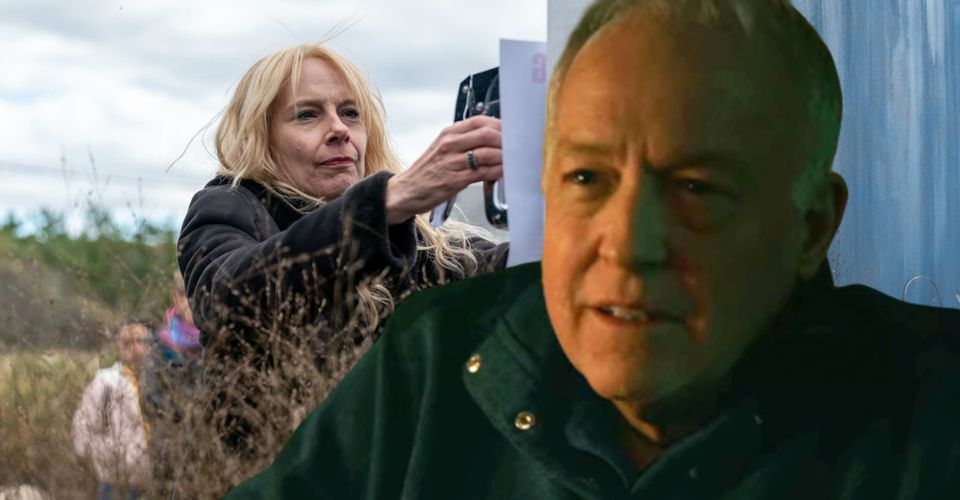Lost Girls True Story: What REALLY Happened With The Long Island Serial Killer

The Netflix film Lost Girls tells the story of the investigation into the Long Island serial killer, but what really happened with the mysterious murderer? In terms of the history of modern true crime and unsolved murders, few cases have fascinated and baffled the authorities and public at large quite like the case of the Long Island serial killer. Also known as the Gilgo Beach killer and Craigslist Ripper, this unidentified figure is believed to have been responsible for the murders of anywhere between 10 and 16 people committed over two decades. The victims were mostly women, many of whom have not been identified to this day, and the ones who have were known to have worked or been associated with sex work. Their bodies were left on the South Shore of Long Island, New York, often for years before being discovered.
In 2013, journalist Robert Kolker published Lost Girls: An Unsolved American Mystery. The book fully detailed not only the murders but the lives of the oft-forgotten women who were struck down by this unknown killer. Kolker notes that the victims’ statuses as vulnerable women – working class, sex workers, ones with previous criminal convictions or reputations as “trouble makers” — meant that they were never considered priorities by the authorities who were supposed to protect them.
Lost Girls is so effective because it does not judge these women like society so often did and it gives them back their identities after years of being known simply as Jane Does and tragic victims. The book also digs into how the women’s families were the ones who forced the police and public to care about their loss. It’s a deeply human book and its Netflix original movie adaptation of the same name, directed by Liz Garbus, thankfully captures that empathy.
The Long Island Serial Killer In Netflix’s Lost Girls

Lost Girls, which dropped on Netflix on March 13, 2020, stars Amy Ryan as Mari Gilbert, the mother of Shannan, one of the missing women whose discovery led to the reveal of the Long Island serial killer. In May 2010, Suffolk County Police were searching for Gilbert, who had last been seen running from a client’s home in the area, when a police officer and his sniffer dog discovered what was described as “the skeletal remains of a woman in a nearly disintegrated burlap sack.” Further searches of the area led to the discovery of three more bodies. Four more bodies were discovered in another area nearby over the next few months, followed by the discovery of partial human remains. Altogether, ten bodies or sets of remains were discovered in the area, which include the skeleton of a female toddler and the body of a young Asian male found in women’s clothing who may have been transgender.
Other unsolved murders have been linked to the Long Island killer but not officially so, including the 1982 murder of Tina Foglia, who was found dismembered along the shoulder of the Southern State Parkway, and the 2007 discovery of another Jane Doe whose torso was found in a suitcase washed up on a beach at Harbor Island Park. Lost Girls‘ focus lies primarily on the central four women who are believed to have been the victims of this Long Island killer, plus Shannan Gilbert. Shannan Gilbert’s death was ruled by the authorities to be an accidental drowning, but her family maintains that she too was a victim of the murderer. The film notes that an independent autopsy contradicted the police’s theory, confirming that Gilbert’s injuries “were consistent with homicidal strangulation.”
The story of the Netflix Original movie is less an investigation into the murders themselves than a brutal examination of how misogyny, class, and disdainful attitudes and laws regarding sex work put these women at risk then left them to rot long after they had been murdered. Lost Girls is less a whodunnit than a dissection of a society that sees certain women as disposable. In that sense, you could call Lost Girls the perfect anti-true crime movie. The mystery of the Long Island killer’s identity and motive looms overhead in every scene but the film cannot close the book on the case because it remains unsolved to this day.
Lost Girls sticks pretty closely to the facts of the story, a smart decision given the sensitivity of the subject matter and the recency of these tragic events. The details it doesn’t get into were probably omitted for time and their lack of confirmed closeness to the central story. For instance, the film suggests that the first body discovered on Gilgo Beach happened because a policeman let his sniffer dog out to urinate. This is not the official line from Suffolk County’s police, although it’s still unknown how the discovery happened. Some reports say that officer John Mallia and his dog Blue discovered the body as part of ongoing training while others say it was because they had been sent out on active duty to locate the bodies. Neither or both could be true, but the condensing of events for the Netflix film makes little difference to the overall narrative.
The Long Island Serial Killer In Real Life

While the exact identity of the Long Island killer remains unknown, the authorities have drawn up profiles to help catch him. A 2011 article in The New York Times described him as such:
“He is most likely a white male in his mid-20s to mid-40s. He is married or has a girlfriend. He is well educated and well-spoken. He is financially secure, has a job and owns an expensive car or truck. He may have sought treatment at a hospital for poison ivy infection. As part of his job or interests, he has access to, or a stockpile of, burlap sacks. And he lives or used to live on or near Ocean Parkway on the South Shore of Long Island, where the police have found as many as 10 sets of human remains.”
It is thought that, due to the number of murders committed and the time frame involved, the killer may have a strong knowledge of law enforcement techniques that have helped him to avoid detection. Some have even speculated that he may have ties to policing or the authorities, a notion that has only further exacerbated mistrust of the law in this case.
One of the theories put forward about the murders is that there may have been more than one killer involved. Given the difference in how the various bodies were found and their end state – some were dismembered, others were not – it has been theorized that there are two very different and unconnected murderers at work. The other unknown figure has been nicknamed The Trophy Killer and The Torso Killer, the former coming from the idea that the way they hid the bodies was as a trophy garden of sorts to display his kills. Back in 2011, the official police order was to look for a single killer responsible for all of the ten confirmed deaths discovered on Long Island’s beaches.
The Long Island Serial Killer’s Identity Is Still Unknown

As of March 2020, the identity of the Long Island serial killer remains unknown and nobody has been charged with the murder of these victims. In January of this year, the police released pictures of a belt they believe belonged to or was handled by the murderer, which carries the initials WH or HM. It is unknown why the authorities held onto this evidence for nine years before releasing it.
There have been various suspects over the years. The primary one who falls under the focus of Netflix movie Lost Girls is Dr. Peter Hackett, a resident of Oak Beach who claimed to Shannan Gilbert’s mother that he had been taking care of her in a “home for wayward girls” that he ran. Three days after making that call, he phoned Gilbert again, this time to deny that he’d ever had any contact with Shannan. Investigators later confirmed through phone records that Hackett called Mari Gilbert twice following the disappearance. After Shannan’s body was found near Hackett’s home, he became the primary suspect in the murders, although he was later ruled out by police, who revealed that he had a long history of positioning himself as a hero or crucial part in certain major events. The Gilbert family maintains that he is responsible for Shannan’s death and filed a wrongful death suit against him in 2012.
In 2016, the Gilbert family announced that they had been in contact with an escort who had conducted business with former Suffolk County Police Chief James Burke and who claimed that he was connected to the Gilgo Beach deaths. At the time, Burke was in the midst of serving a 46-month prison sentence for unrelated crimes.
In September 2017, Suffolk County prosecutors named local carpenter John Bittrolff as a key suspect. He had already been charged and imprisoned for the murders of two women who were sex workers in 2014 and he remains a major suspect in the death of a third. The remains of two of the official Long Island killer victims were discovered very close to Bittrolff’s home. One of the women he was convicted of killing also reportedly shared a connection with Melissa Barthelemy, one of the first discovered Long Island killer victims.
Another possible suspect is James Bissett, a local business owner who ran a nursery in the area. As the main supplier of burlap in the region, he certainly seemed like a major suspect given that the killer would have needed to have ready and plentiful access to the material. Two days after Shannan Gilbert’s remains were found, Bissett died by suicide.
Lost Girls is now available to stream on Netflix.
About The Author


















